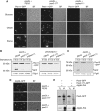Pex3-anchored Atg36 tags peroxisomes for degradation in Saccharomyces cerevisiae
- PMID: 22643220
- PMCID: PMC3395097
- DOI: 10.1038/emboj.2012.151
Pex3-anchored Atg36 tags peroxisomes for degradation in Saccharomyces cerevisiae
Abstract
Peroxisomes undergo rapid, selective autophagic degradation (pexophagy) when the metabolic pathways they contain are no longer required for cellular metabolism. Pex3 is central to the formation of peroxisomes and their segregation because it recruits factors specific for these functions. Here, we describe a novel Saccharomyces cerevisiae protein that interacts with Pex3 at the peroxisomal membrane. We name this protein Atg36 as its absence blocks pexophagy, and its overexpression induces pexophagy. We have isolated pex3 alleles blocked specifically in pexophagy that cannot recruit Atg36 to peroxisomes. Atg36 is recruited to mitochondria if Pex3 is redirected there, where it restores mitophagy in cells lacking the mitophagy receptor Atg32. Furthermore, Atg36 binds Atg8 and the adaptor Atg11 that links receptors for selective types of autophagy to the core autophagy machinery. Atg36 delivers peroxisomes to the preautophagosomal structure before being internalised into the vacuole with peroxisomes. We conclude that Pex3 recruits the pexophagy receptor Atg36. This reinforces the pivotal role played by Pex3 in coordinating the size of the peroxisome pool, and establishes its role in pexophagy in S. cerevisiae.
Conflict of interest statement
The authors declare that they have no conflict of interest.
Figures








Comment in
-
Up for grabs; trashing peroxisomes.EMBO J. 2012 Jun 29;31(13):2835-6. doi: 10.1038/emboj.2012.152. Epub 2012 May 29. EMBO J. 2012. PMID: 22643221 Free PMC article.
-
Autophagy: Who presses the self-destruct button?Nat Rev Mol Cell Biol. 2012 Jun 20;13(7):406. doi: 10.1038/nrm3384. Nat Rev Mol Cell Biol. 2012. PMID: 22713969 No abstract available.
References
-
- Barnard E, McFerran NV, Trudgett A, Nelson J, Timson DJ (2008) Development and implementation of split-GFP-based bimolecular fluorescence complementation (BiFC) assays in yeast. Biochem Soc Trans 36: 479–482 - PubMed
-
- Bartel P, Chien CT, Sternglanz R, Fields S (1993) Elimination of false positives that arise in using the two-hybrid system. Biotechniques 14: 920–924 - PubMed
-
- Bellu AR, Komori M, van der Klei IJ, Kiel JA, Veenhuis M (2001) Peroxisome biogenesis and selective degradation converge at Pex14p. J Biol Chem 276: 44570–44574 - PubMed
Publication types
MeSH terms
Substances
Grants and funding
LinkOut - more resources
Full Text Sources
Other Literature Sources
Molecular Biology Databases

